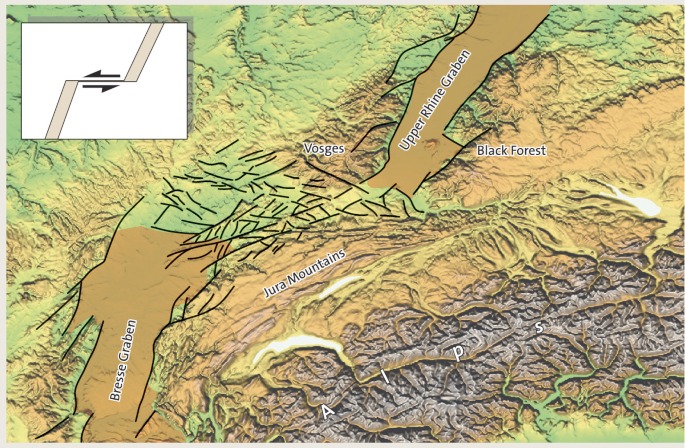Frog legs and dinosaur feet on the menu in stage 13. Today the flat Dombes region over the Bresse Basin slowly turns into the tortuous Jura mountains. Both the Bresse Basin and the Jura formed as a result of the collision of the African continent with Eurasia. This started around 50 million years ago when the African plate advancing northward impinged into Europe.
The Bresse Basin formed as part of a long and narrow gash opening from the Mediterranean all the way to the North Sea. In the gash, or graben, shallow seas evaporated regularly. At this time the climate was extremely hot due to high CO2 levels. When the connections with the seas would close, giant and very flat salt pans formed. The graben continued to sink so that it filled up with kilometer-thick layers of salt until 20 million years ago.

After this, not much happened. That’s why the salt pans now lay not far below the flat region. However, our riders should expect nothing like the racetracks of the Bonneville Salt Flats (Utah). In fact they might be surprised by the badland topography. During the last glacial period 25,000 to 10,000 years ago, glaciers descending from the Alps carved trenches and carried rocks on their backs. When they melted, they littered the plains with so-called “moraines”, large piles of rocks forming hills.
Frog legs
The riders will swing around those moraines and trenches now hosting hundreds of ponds that characterize this bucolic Dombes region. Over a thousand years ago, clever monks started to use these ponds to fish. But not only fish! They became most famous for the frog legs. The monks sold these to the city of Lyon when food became scarce.

Riders will start climbing in Ambrieux-en-Buguey. This is precisely the point with fault thrusting the Jura mountains over the Bresse Basin. The Jura mountain formed at the periphery of the uplifting Alps as Italy moved northward into France. It was like a bulldozer pushing ground forward. In front of the Alpine bulldozer, older layers of sediments deep in the Earth were folded, squeezed, brought up to the surface and thrust over the Bresse basin.
Cocktail anyone?
In Culoz, at the base of the last and most serious climb of the Grand Colombier, riders will clang to white layers of very old limestones sediments. These contain reef fossils showing conditions resembling those of the Bahamas that prevailed when these rocks formed. The steep climb snaking up the switchbacks along the road’s hairpins will lead them through these white limestone layers that are folded along the road. These folds testify of the tectonic forces that formed these mountains and adds to the dizzying and dramatic scenery. These sediments are visible in the Jura mountains in a beautiful way. That’s how early geologists named the Jurassic period (201-145 million years ago) and its famous dinosaurs after the Jura.
Big dinosaur feet

Riders will climb through most of the 54 million year-long Jurassic period. When they finally reach the top, they will be see the Late Jurassic rocks. These bear the fossils that constitute the Jurassic Park bestiary that used to roam the region. These include “Maxime” an ostrich-sized carnivorous theropod running on two limb. Also present was “Odysseus”, a 35-meter long, 35-ton type of diplodocus on four huge limbs. The footsteps they left behind were immortalized in stone.
The question is whether Odysseus actually was this huge as the spectacular research seemed to show? The answer to that follows in stage 19.





